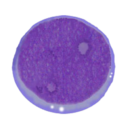The flow cytometric diagnosis of AML: Difference between revisions
From haematologyetc.co.uk
No edit summary |
No edit summary Tag: Manual revert |
||
| Line 2: | Line 2: | ||
---- | ---- | ||
* | *For most cases, the diagnosis of AML by flow cytometry is relatively straightforward, and can be addressed in a structured manner. | ||
* | *The key is to ensure atypical cases are identified and unusual diagnoses are not missed. The workflow here is based on WHO criteria. | ||
---- | ---- | ||
Revision as of 13:12, 13 December 2023
- For most cases, the diagnosis of AML by flow cytometry is relatively straightforward, and can be addressed in a structured manner.
- The key is to ensure atypical cases are identified and unusual diagnoses are not missed. The workflow here is based on WHO criteria.
Principle 1. The cells should show flow cytometric features consistent with a primitive nature
 Blast cells typically have "primitive" morphology, the initial procedure is to ensure that the cells also express markers of early differentiation
Blast cells typically have "primitive" morphology, the initial procedure is to ensure that the cells also express markers of early differentiation
- Most often in AML useful features of immature cells are weak expression of CD45, and expression of CD34 and/or CD117. However, other markers may be useful (See Markers used to demonstrate primitive nature in AML)
- Note that some cases there may be atypical features where primitive nature is less clear, this is most frequently encoutered in more mature monocytic cases of AML or in APL, but also in other circumstances (see table Atypical patterns of primitive marker expression in acute myeloid leukaemia)
Can we confirm myeloid nature?
- Typical cases can generally be recognised by (see table for details)
- Atypical cases can still be identified based on a minimal feature set (see table for details)
- In unusual cases an extended marker panel may allow lineage assignment (see Table for details)
Are there atypical features?
- Expected abberency
- Feature that may give concern